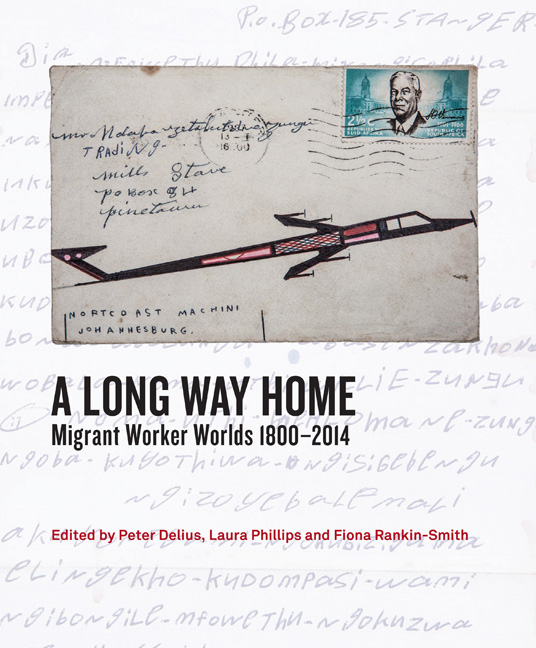Book contents
- Frontmatter
- Contents
- Acknowledgements
- Introduction: Highlighting Migrant Humanity
- Chapter 1 Ngezinyawo - Migrant Journeys
- Chapter 2 Slavery, Indenture and Migrant Labour: Maritime Immigration from Mozambique to the Cape, c.1780–1880
- Chapter 3 Walking 2 000 Kilometres to Work and Back: The Wandering Bassuto by Carl Richter
- Chapter 4 A Century of Migrancy from Mpondoland
- Chapter 5 The Migrant Kings of Zululand
- Chapter 6 The Art of Those Left Behind: Women, Beadwork and Bodies
- Chapter 7 The Illusion of Safety: Migrant Labour and Occupational Disease on South Africa's Gold Mines
- Chapter 8 ‘The Chinese Experiment’: Images from the Expansion of South Africas ‘Labour Empire’
- Chapter 9 ‘Stray Boys’: The Kruger National Park and Migrant Labour
- Chapter 10 Surviving Drought: Migrancy and the Homestead Economy
- Chapter 11 Migrants from Zebediela and Shifting Identities on the Rand, 1930s–1970s
- Chapter 12 Verwoerd's Oxen: Performing Labour Migrancy in Southern Africa
- Chapter 13 ‘Give My Regards to Everyone at Home Including Those I No Longer Remember’: The Journey of Tito Zungu's Envelopes
- Chapter 14 Sophie and the City: Womanhood, Labour and Migrancy
- Chapter 15 Bungityala
- Chapter 16 Migrants: Vanguard of the Worker's Struggles?
- Chapter 17 Debt or Savings? Of Migrants, Mines and Money
- Chapter 18 Post-Apartheid Migrancy and the Life of a Pondo Mineworker
- Notes on Contributors
- List of Figures and Tables
- Index
Chapter 13 - ‘Give My Regards to Everyone at Home Including Those I No Longer Remember’: The Journey of Tito Zungu's Envelopes
Published online by Cambridge University Press: 04 July 2018
- Frontmatter
- Contents
- Acknowledgements
- Introduction: Highlighting Migrant Humanity
- Chapter 1 Ngezinyawo - Migrant Journeys
- Chapter 2 Slavery, Indenture and Migrant Labour: Maritime Immigration from Mozambique to the Cape, c.1780–1880
- Chapter 3 Walking 2 000 Kilometres to Work and Back: The Wandering Bassuto by Carl Richter
- Chapter 4 A Century of Migrancy from Mpondoland
- Chapter 5 The Migrant Kings of Zululand
- Chapter 6 The Art of Those Left Behind: Women, Beadwork and Bodies
- Chapter 7 The Illusion of Safety: Migrant Labour and Occupational Disease on South Africa's Gold Mines
- Chapter 8 ‘The Chinese Experiment’: Images from the Expansion of South Africas ‘Labour Empire’
- Chapter 9 ‘Stray Boys’: The Kruger National Park and Migrant Labour
- Chapter 10 Surviving Drought: Migrancy and the Homestead Economy
- Chapter 11 Migrants from Zebediela and Shifting Identities on the Rand, 1930s–1970s
- Chapter 12 Verwoerd's Oxen: Performing Labour Migrancy in Southern Africa
- Chapter 13 ‘Give My Regards to Everyone at Home Including Those I No Longer Remember’: The Journey of Tito Zungu's Envelopes
- Chapter 14 Sophie and the City: Womanhood, Labour and Migrancy
- Chapter 15 Bungityala
- Chapter 16 Migrants: Vanguard of the Worker's Struggles?
- Chapter 17 Debt or Savings? Of Migrants, Mines and Money
- Chapter 18 Post-Apartheid Migrancy and the Life of a Pondo Mineworker
- Notes on Contributors
- List of Figures and Tables
- Index
Summary
Although the distance involved in the artist Tito Zungu's journey between work and home was relatively short, compared to the trans-country journeys travelled by many mineworkers, for example, his life was nonetheless defined by South Africa's migrant labour system. His experience therefore overlaps with that of many others. However, Zungu created an art form arising out of his experience that is unique. His renowned, hand-embellished envelopes can be seen as powerful symbols of the journey between rural homestead and urban centre. The envelopes were originally made as literal containers of letters, mechanisms for communicating with correspondents far away. After his work was introduced to the art market, the envelopes came instead to be regarded as artworks, ending their journey as highly sought-after objects in collections around the world.
In 1999, shortly before his death in January 2000, Wits Art Museum (WAM, then the University of the Witwatersrand Art Galleries) approved the purchase of a collection of 46 envelopes, 4 drawings and a diary from the artist. This collection forms part of the Standard Bank African Art Collection holdings of Zungu's works at WAM, the other items being two drawings that were acquired by the university in 1987. The envelopes have discernibly been sent through the mail; they are franked and creased, the texture worn so soft it resembles fabric, rather than crisp paper. Many have suffered losses from insect damage and some are stained from contact with liquid. All show evidence of wear and tear from having been extensively handled. All have been carefully slit open on one short side to extract the contents; none have had their flaps torn open. The backs of a few have been used for apparently unrelated calculations or scrawls. In addition to the address and postage stamp, 25 of the envelopes, more than half, have meticulous ballpoint pen images of aeroplanes drawn across their front surfaces. There are other images too: a complex image of a ship filling the envelope, a radio, two depict homesteads, others include flowers, foliage or geometric shapes. On many, embellished words and letters form part of the design. Eight envelopes have no drawings at all and do not appear to have been created by the artist.
- Type
- Chapter
- Information
- A Long Way HomeMigrant Worker Worlds 1800–2014, pp. 186 - 200Publisher: Wits University PressPrint publication year: 2014

